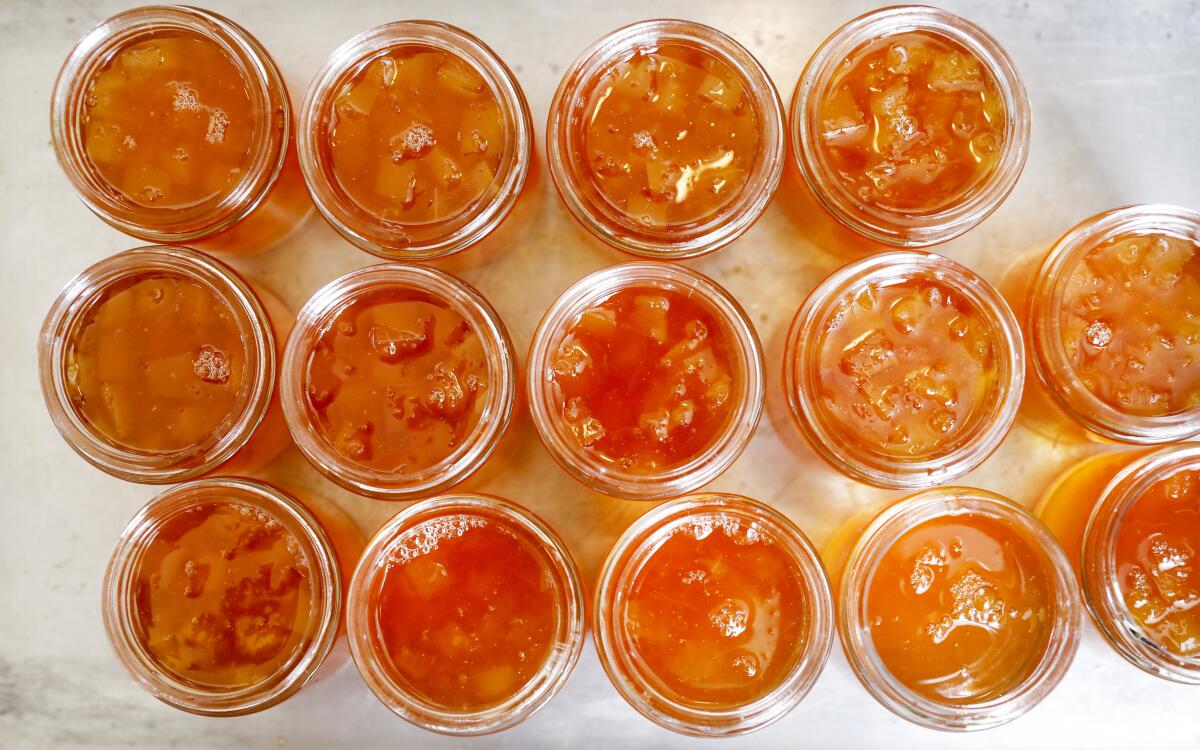Oro Blanco Marmalade

This marmalade comes from Sonoko Sakai and Alaina Wong, who collaborate to turn Sakai’s backyard oro blanco tree harvest into a bejeweled fruit preserve. The method was shared with Sakai by her friend Saba Parsa, the creator of Saba Jams. This recipe takes two days and uses all of the grapefruit — juice, pith and rind — so, if possible, use high-quality, organic fruits. Use a 12-quart pan and do not double the recipe. The mixture should not be more than two-thirds of the pan’s volume, as it will affect the texture and color of the marmalade. Oro blancos are common in Southern California markets this time of year, but if you can’t find them, use another fragrant, sweet grapefruit variety like ruby red.
This recipe was featured in the story “Seasons of Preserves: Citrus Marmalade.”
Clean the grapefruits and lemons, then divide the grapefruits into 1,360 grams (3 pounds) and 680 grams (1 1/2 pounds) groupings. Halve and juice all of the lemons and discard the spent halves. Halve and juice all the grapefruits, then combine their juices together with the lemon juice, but keep the grapefruit peels in their separate groups. Place the sugar in a large nonreactive container or bowl. With the finest sieve you have, strain the combined juices into the container and mix until well combined (you do not need to dissolve the sugar; just combine it with the juice). Seal with a lid and refrigerate the syrup until ready to use.
Place the 1,360 grams (3 pounds) grapefruit halves into a large saucepan and cover with cold water. Bring to a boil and then lower the heat to maintain a steady simmer. Cover with the lid and cook until the liquid becomes syrupy, 3 to 4 hours. As the rinds cook, occasionally press down on them, and ensure the water level stays high so that the grapefruit halves are submerged.
Remove the pot from the heat and let the rinds cool completely in the liquid. Pour the liquid through a fine sieve into a large container or bowl, gently pressing on the halves to extract as much liquid as possible. The liquid should be clear. If the liquid turns cloudy, the halves are being squeezed too much, which results in adding further pectin to the marmalade. Refrigerate the cooking liquid overnight or up to 24 hours.
Meanwhile, place the 680 grams (1 1/2 pounds) grapefruit halves in a large saucepan and cover with cold water. Bring to a boil, then lower the heat to maintain a steady simmer and cook for 5 minutes. Drain the grapefruit and discard the water. Repeat this process one more time. Then return the halves to the pot, cover with cold water and bring to a boil once more. Reduce the heat to maintain a steady simmer and cook, with the pot lid ajar, until the rinds are tender or can be easily pierced with a sharp knife, 1 to 2 hours. The water level should stay high enough that the rinds are floating. Remove the pot from the heat, cover completely with the lid and let it sit at room temperature overnight.
The next day, remove the grapefruit halves from the liquid in the pot; reserve the liquid. Using a small spoon, scoop out the membranes and fibers from the halves and reserve them in a bowl. Coarsely chop the membranes and fibers, and return them to the bowl. Cut the scraped rinds lengthwise into 4 to 5 long strips, then cut each strip crosswise into small chunks or squares.
Strain the cooking liquid through a sieve into a large, wide pot. Add the refrigerated cooking liquid, the refrigerated syrup, the chopped membranes and the chopped rinds. Stir the mixture until well combined. Place the pot over high heat and bring to a boil, stirring to ensure the sugar is fully dissolved. Attach a candy thermometer to the side of the pot, if you like.
Once the mixture begins bubbling, stop stirring and do not stir until a steady thick foam appears. Once it starts foaming, reduce the heat slightly and stir every couple of minutes until the marmalade has reached its set point, around 220 degrees on the thermometer. To test if the marmalade is set, perform the “plate test” by taking a spoonful of marmalade, placing it on a frozen small plate and freezing it for 3 to 4 minutes. Run your finger through the marmalade and the skin should begin to wrinkle. If the set point has not been reached, cook for another 5 minutes. This could take up to 35 minutes depending on the oro blancos’ pectin levels.
When the marmalade has reached its set point, take the pan off the heat and let it sit for 5 minutes. Scrape away any foam using a spoon. Using a ladle and a jam funnel, pour the marmalade into jars. Wipe the rims, fasten the lids tightly and let them cool.
Get our Cooking newsletter.
Your roundup of inspiring recipes and kitchen tricks.
You may occasionally receive promotional content from the Los Angeles Times.









